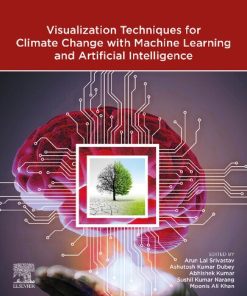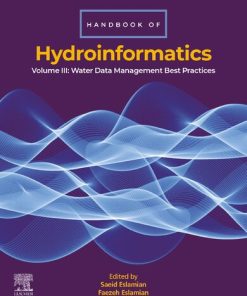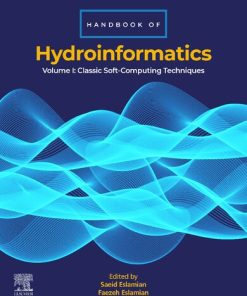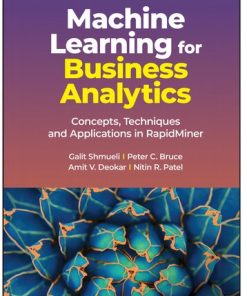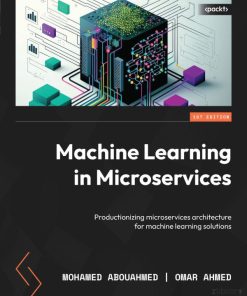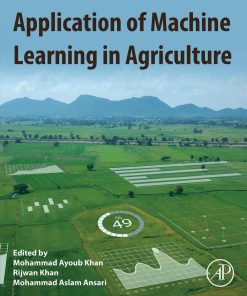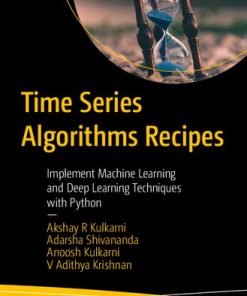Handbook of HydroInformatics Volume II Advanced Machine Learning Techniques 1st edition by Saeid Eslamian, Faezeh Eslamian 0128219508 9780128219508
$50.00 Original price was: $50.00.$25.00Current price is: $25.00.
Handbook of HydroInformatics: Volume II: Advanced Machine Learning Techniques 1st edition by Saeid Eslamian, Faezeh Eslamian – Ebook PDF Instant Download/DeliveryISBN: 0128219508, 9780128219508
Full download Handbook of HydroInformatics: Volume II: Advanced Machine Learning Techniques 1st edition after payment.

Product details:
ISBN-10 : 0128219508
ISBN-13 : 9780128219508
Author: Saeid Eslamian, Faezeh Eslamian
Advanced Machine Learning Techniques includes the theoretical foundations of modern machine learning, as well as advanced methods and frameworks used in modern machine learning. Handbook of HydroInformatics, Volume II: Advanced Machine Learning Techniques presents both the art of designing good learning algorithms, as well as the science of analyzing an algorithm’s computational and statistical properties and performance guarantees. The global contributors cover theoretical foundational topics such as computational and statistical convergence rates, minimax estimation, and concentration of measure as well as advanced machine learning methods, such as nonparametric density estimation, nonparametric regression, and Bayesian estimation; additionally, advanced frameworks such as privacy, causality, and stochastic learning algorithms are also included. Lastly, the volume presents Cloud and Cluster Computing, Data Fusion Techniques, Empirical Orthogonal Functions and Teleconnection, Internet of Things, Kernel-Based Modeling, Large Eddy Simulation, Patter Recognition, Uncertainty-Based Resiliency Evaluation, and Volume-Based Inverse Mode.
Handbook of HydroInformatics: Volume II: Advanced Machine Learning Techniques 1st Table of contents:
Chapter 1: Analyzing spatiotemporal variation of land use and land cover data
Abstract
Acknowledgment
1: Introduction
2: Data preparation
3: Visual interpretations
4: LULC distribution
5: LULC change detection
6: Image interpretation
7: LAI model
8: Compare the visual interpretation vs image interpretation
9: Conclusions
References
Chapter 2: Artificial Intelligence-based model fusion approach in hydroclimatic studies
Abstract
1: Introduction
2: Mathematical concepts
3: Some applications
4: Conclusions
References
Chapter 3: Computations of probable maximum precipitation estimates
Abstract
1: Introduction
2: Methodology of PMP estimation
3: Statistical PMP estimates: A case-study
4: Conclusions
References
Chapter 4: Deep learning: Long short-term memory in hydrological time series
Abstract
1: Introduction
2: Model description of long short-term memory (LSTM)
3: Training network and backpropagation
4: Variants of LSTM
5: Normalization and hyperparameter selection
6: LSTM applications in hydrometeorological variables
7: Employed deep learning programs for LSTM
8: Conclusions
References
Chapter 5: Dimensionality reduction of correlated meteorological variables by Bayesian network-based graphical modeling
Abstract
1: Introduction
2: Study area and data used
3: Methodology
4: Results and discussions
5: Conclusions
References
Chapter 6: The ecohydrological function of the tropical forest rainfall interception: Observation and modeling
Abstract
1: Introduction
2: Canopy water balance: concepts and general aspects of the monitoring
3: Measurements of the rainfall interception components
4: Rainfall interception modeling
5: Conclusions
References
Chapter 7: Emotional artificial neural network: A new ANN model in hydroinformatics
Abstract
1: Introduction
2: Mathematical concepts of emotional artificial neural network
3: Some applications of EANN
4: Conclusions
References
Chapter 8: Exploring nature-based adaptation solutions for urban ecohydrology: Definitions, concepts, institutional framework, and demonstration
Abstract
Acknowledgments
1: Introduction
2: Nature-based adaptation solutions (NBaS): Conceptual framework and position
3: NbaS and ecohydrology
4: The need for physically-based evidence
5: Conclusions
References
Chapter 9: Fuzzy-based large-scale teleconnection modeling of monthly precipitation
Abstract
1: Introduction
2: Materials and methods
3: Results and discussion
4: Conclusions
References
Chapter 10: Hydrologic models classification, calibration, and validation
Abstract
1: Introduction
2: Hydrological modeling for integrated water management
3: Model calibration and validation
4: Conclusions
References
Further reading
Chapter 11: Identification of soil erosion sites in semiarid zones: Using GIS, remote sensing, and PAP/RAC model
Abstract
1: Introduction
2: Materials and method
3: Results and discussion
4: Conclusions
References
Chapter 12: Metrics of the water performance engineering modeling
Abstract
1: Introduction
2: Types of hydro-climatological modeling and metrics
3: Some applications of the metrics
4: Agenda for future studies
References
Chapter 13: Outlier robust extreme learning machine: Predicting river water temperature in the absence of air temperature
Abstract
1: Introduction
2: Study area and data
3: Materials and methods
4: Results and discussion
5: Conclusions
References
Chapter 14: Parametric and nonparametric methods for analyzing the trend of extreme events
Abstract
1: Introduction
2: Trend calculation methods
3: Case studies
4: Conclusions
References
Chapter 15: Voting-based extreme learning machine: Potential of linking soil moisture content to soil temperature
Abstract
1: Introduction
2: Materials and methods
3: Results and discussion
4: Conclusions
References
Chapter 16: Prediction of reference crop evapotranspiration: Empirical and machine learning approaches
Abstract
1: Introduction
2: An overview of various empirical methods for reference evapotranspiration estimation
3: Estimation of ET0 using empirical models
4: Machine learning techniques used for estimation of evapotranspiration
5: Modeling of ET0 using machine learning techniques
6: Deep learning techniques in modeling of ET0
7: Case study
8: Conclusions
References
Chapter 17: Reference evapotranspiration in water requirement: Theory, concepts, and methods of estimation
Abstract
1: Introduction
2: Theory of evapotranspiration
3: Methods of calculating the reference evapotranspiration
4: Conclusions
References
Chapter 18: Extremely randomized trees versus random forest, group method of data handling, and artificial neural network
Abstract
1: Introduction
2: Study area and data
3: Methodology
4: Results and discussion
5: Conclusions
References
Chapter 19: Index of resilience and effectiveness of disaster risk management
Abstract
1: Introduction
2: The disaster risk management index, DRMi
3: Evaluation for Latin America and the Caribbean region
4: Conclusions
References
Chapter 20: Wavelet decomposition based on Gaussian process regression and multiple linear regression: Monthly reservoir evaporation prediction
Abstract
1: Introduction
2: Materials and method
3: Evaluation criteria
4: Results and discussion
5: Conclusions
References
Chapter 21: Sequential Monte-Carlo methods in hydroclimatology
Abstract
1: Introduction
2: Bayes’ theorem
3: Basics of sequential Monte-Carlo methods
4: Particle filters for high-dimensional geoscience applications
5: Adaptive estimation using particle filter
6: Conclusions
References
Chapter 22: Smart cities and hydroinformatics
Abstract
1: The history of urbanization and smart cities
2: Definition of a Smart City
3: Components of a Smart City
4: Smart cities and internet of things
5: Smart City strategies
6: Smart cities and hydroinformatics
7: Conclusions
References
Chapter 23: Support vector regression model optimized with GWO versus GA algorithms: Estimating daily pan-evaporation
Abstract
1: Introduction
2: Study location and data collection
3: Methodology
4: Results and discussion
5: Conclusions
References
Chapter 24: Univariate, multivariate L-moments and copula functions for drought analysis
Abstract
1: Introduction
2: Materials and methods
3: Results
4: Conclusions
People also search for Handbook of HydroInformatics: Volume II: Advanced Machine Learning Techniques 1st:
handbook of hydroinformatics pdf
handbook definition and examples
handbook of hydrology
handbook of hydraulic fluid technology
handbook of hydraulic resistance
Tags: Handbook, HydroInformatics, Advanced Machine, Techniques, Saeid Eslamian, Faezeh Eslamian
You may also like…
Uncategorized
Engineering
Computers - Artificial Intelligence (AI)
Computers - Programming




